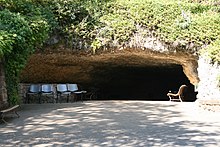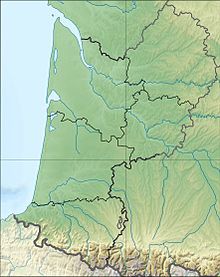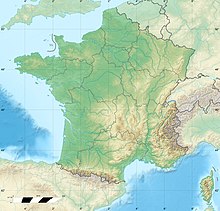Rouffignac Cave
| Grotte de Rouffignac | |

Rouffignac Cave
|
|
| Alternate name | Cave of the hundred mammoths, Miremont cave, Cro des Cluzeau, Cro de Granville |
|---|---|
| Location | Rouffignac-Saint-Cernin-de-Reilhac |
| Region | Dordogne, France |
| Coordinates | 45°00′32″N 0°59′15″E / 45.00889°N 0.98750°ECoordinates: 45°00′32″N 0°59′15″E / 45.00889°N 0.98750°E |
| History | |
| Cultures | Magdalenian |
| Site notes | |
| UNESCO World Heritage Site | |
| Criteria | (i), (iii) |
| Reference | 85-012 |
| Inscription | 1979 (3rd Session) |
|
[]
|
|
The Rouffignac cave, situated within the French commune of Rouffignac-Saint-Cernin-de-Reilhac in the Dordogne département, contains over 250 engravings and cave paintings dating back to the Upper Paleolithic.
The Cave of the hundred mammoths, also known as Miremont cave, Cro des Cluzeau or Cro de Granville, is situated about 5 km (3.1 mi) south of Rouffignac on a hill slope along the right hand side of the La Binche river, a left tributary of the Manaurie. Perched only about one kilometer farther east on the opposite side of the valley is the little village of Fleurac. The country rocks of the cave are flat-lying limestones belonging to the uppermost Coniacian; they are very rich in flint nodules. These rocks together with overlying Santonian rocks form the limestone plateau of Légal, the divide between the drainage basins of the rivers Lisle and Vézère.
The Rouffignac cave and the Villars Cave possess the most extensive cave system of the Périgord with more than 8 km (5.0 mi) of underground passageways. There are 10 natural shafts that lead to a deeper level. It is astonishing that most of the artistic representations nearly always seem to be associated with these dangerous places. So far, a further 4 km (2.5 mi) of passageways have been explored in this deeper level. Below the deeper level exists a bottom level with a small underground rivulet. Visitors of the cave have to board an electric train that takes them about 2 km (1.2 mi) into the interior.
The plan of the cave reveals a fractal-like dendritic pattern that is not random but organized along certain preferred directions. Presumably the cave was formed during the Pliocene about 3 to 2 million years ago. Water had infiltrated the bedrock along certain zones of weakness and dissolved the limestone. Today this process has come to an end, the cave is mostly dry except for the rivulet along the base level.
...
Wikipedia


